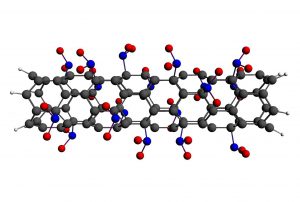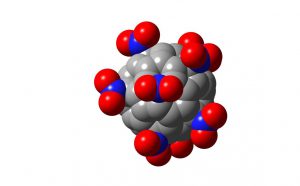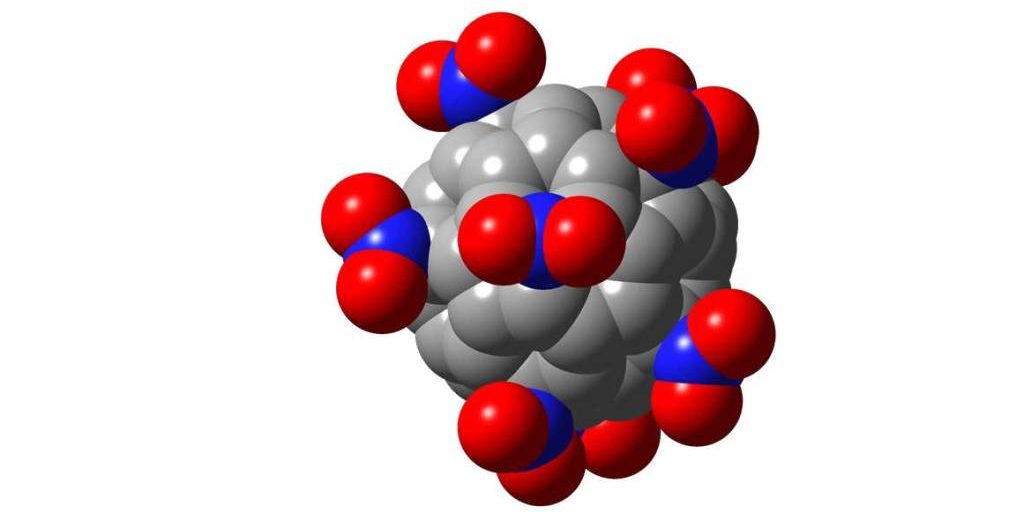An explosion is a quick release of a significant amount of energy from a spontaneous chemical reaction. The liberated energy is expelled in all directions, provides yellow to red flames, and forms various gases, e.g., carbon monoxide, carbon dioxide, and molecular nitrogen, containing double and triple covalent bonds. The explosion reaction, once initiated, is simultaneously driven by large exothermic and positive entropy changes.

Molecular Configuration of C90 (NO2)18 Before Detonation (Credit: Vitaly Chaban, Ph.D.).
Currently, explosives are on a macroscale, making them difficult to test, manage, and tune for specific actions. If explosives were developed on a nanoscale, they would offer even more robust warfare chemical entities able to penetrate the human body and living cells. The resulting weapons shall be easier to manage, exhibit more specific action, and be more environmentally friendly. For instance, existing formulations of gun powders and propellants can be deliberately tuned to avoid undesirable detonation and adjust combustion rates. Detonation velocity can also be controlled, to a large extent, through control of nanoparticle size, morphology, and coverage.
Evolving along the lines of the established concept, we developed a buckybomb molecule. The developed buckybomb and nanoscale explosives, in general, offer exciting perspectives. For instance, itis argued that C60 and its certain derivatives accumulate in the vitally important cavity of the AIDS virus, eventually causing itsdeath. Explosion of the buckybomb would strengthen the effect,probably decreasing the number of required fullerene molecules per virus. The same trick can be implemented with the cancer cells. The detonation power at the nanoscale is enough to seriously harm the problematic cell but not enough to destroy neighboring cells. Once a proper mechanism to deliver nanoscale bombs to the needed cells is established, a highly precise destruction of the living matter will become doable.

Molecular Configuration of C60 (NO2)8 (Credit: Vitaly Chaban,Ph.D.).
In view of existing nanoparticles and known macroscale explosives, the following concept of nanoscale explosives has been formulated by our group:
1. A nanoparticle constitutes a source of chemical energy stored in covalent bonds. The conditions of detonation must support complete liberation of covalent energy, i.e., complete decomposition of a nanoparticle.
2. Nanoparticle size is an easily tunable property through synthesis and maintenance conditions. Larger nanoparticles normally offer larger liberated heats. However, larger nanoparticles exhibit smaller surface area-to-volume ratio, which hinders decomposition reaction. A robust balance must be located between energy yield and reaction rate.
3. A nanoparticle must be functionalized by appropriate groups. Upon initiation, these groups must issue the first portion of energy that is immediately converted into kinetic/phonon energy. The well-known groups employed in the current commercial explosives are -NO2, -ONO2, and -NHNO2. The surface coverage of the nanoparticle must be commensurate with its volume.
The buckybomb molecule was developed by grafting 12 nitrogroups to the C60 fullerene [J. Phys. Chem. Lett., 2015, 6 (5), 913–917]. The buckybomb, C60(NO2)12, detonates very fast once it gets an initial impulse (immediate heating to 1000 K). The exothermic detonation reaction brings a few additional thousands of kelvins. In turn, the synthesized stable gases are responsible for a few thousands of bars. The composition of the products depends on the environment. For a stronger effect, it must supply enough oxidants.

The Buckybomb Molecule in the Highest Occupied, Molecular,Orbital State (Credit: Vitaly Chaban, Ph.D.).
As follows from our analysis and general chemical wisdom, the nanoscale explosions and explosives exhibit a few advantages over traditional [macroscale] detonation technologies:
- If macroscopic explosive can be reformulated in the form of nanoexplosive, its detonation characteristics can be safety tested since nanoexplosion cannot be dangerous to humans.
- The heat is precisely liberated to target an individual living cell, cancer cell, virus or bacterium, whereas not harming others.
- Control of the nanoparticle composition allows control over reaction products, which can be made poisonous or, conversely, safe.
- Morphology (surface area) can be modulated at the stage of synthesis, whereas, this allows modulating detonation process at the stage of detonation.
- The only way to tune reactivity of a conventional explosive is to mix several chemicals to obtain a composition with right properties. Nanoparticles support adjusting the reactive properties through the structure of the given explosive, i.e., within the same molecule.
Progress within the developing field requires intensive interaction between experts of synthetic nanotechnology, molecular biology, and numerical simulations. The existing theoretical techniques can display detonation in real-time at a truly atomistic resolution, thus providing wealth of information regarding kinetics and thermodynamics of the underlying chemical reactions.
For a pdf version of this spotlight, click here.

Author Contact Information:
e-mail: vvchaban@gmail.com
Telephone: +1 (413) 642-1688


